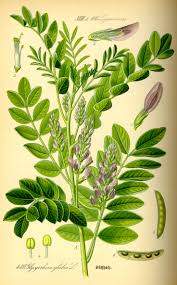The licorice plant, known scientifically as *Glycyrrhiza glabra*, is a remarkable perennial herb renowned for its distinctive sweet flavor, medicinal properties, and ornamental appeal. Whether you’re a gardening enthusiast or someone interested in natural herbal remedies, the licorice plant offers a wide range of benefits. This hardy plant has been cultivated for centuries across Europe, Asia, and the Middle East, and it continues to be cherished for both its functional and aesthetic uses.
### **What Makes the Licorice Plant Unique?**
Licorice plants are easily recognized by their tall stems, narrow leaflets, and delicate lavender or pale blue flowers. However, the real treasure lies beneath the surface—its roots. Licorice roots contain glycyrrhizin, a natural compound that is up to 50 times sweeter than sugar. This makes licorice an extremely popular ingredient in candies, teas, herbal medicines, and flavoring agents.
The plant also contains a range of beneficial compounds, including flavonoids and antioxidants, which have been associated with anti-inflammatory, antimicrobial, and mucus-clearing properties. These advantages make licorice a powerful addition to your herbal garden or wellness routine.
### **Ideal Growing Conditions for Licorice Plants**
While licorice plants may look delicate, they are surprisingly resilient when planted in the right environment. They thrive best in full sunlight and well-drained, sandy soil. Because they are native to warm climates, they prefer temperatures between 70–85°F during their growing season.
Watering should be consistent but moderate. Overwatering can cause root rot, so proper drainage is essential. Mulching can help regulate moisture levels and protect the roots. Licorice plants can grow up to 5 feet tall, so they need plenty of space to spread out. If you’re considering growing licorice in your garden, ensure ample ground room or use a large container to accommodate its deep root system.
### **Harvesting and Using Licorice Root**
Most gardeners harvest licorice roots after two to three years of growth, when they are mature and fully developed. Once harvested, the roots can be washed, dried, and stored for future use. Traditionally, licorice root is boiled into teas, extracted into syrups, or ground into powders for medicinal purposes.
In addition to its natural sweetness, licorice root is widely valued for its digestive benefits. It is commonly used to soothe sore throats, support respiratory health, and improve gut balance. However, due to its potency, licorice should be consumed in moderation, especially by individuals with heart or blood pressure conditions.
### **Ornamental Uses in Landscaping**
While the medicinal licorice plant (*Glycyrrhiza glabra*) is highly valued, the ornamental licorice plant (*Helichrysum petiolare*) has also gained popularity for its attractive silver foliage and trailing growth habit. This variety is often used in hanging baskets, borders, and rock gardens, bringing texture and elegance to outdoor spaces.
### **Why Gardeners Love the Licorice Plant**
Gardeners choose licorice plants for their versatility, beauty, and health benefits. Whether you want a visually appealing plant or a natural herbal remedy, licorice delivers exceptional value. For those seeking high-quality gardening supplies to support plant growth, resources like superiorhydrola.com can offer helpful tools and guidance.
—
By understanding the unique qualities of the licorice plant and how to cultivate it properly, you can enjoy its many benefits for years to come. This timeless herb is not only beautiful but also deeply connected to natural wellness and sustainable gardening practices.
